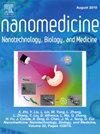光热AFM-IR法测定泪液中糖尿病疾病标志物。
IF 4.6
2区 医学
Q2 MEDICINE, RESEARCH & EXPERIMENTAL
Nanomedicine : nanotechnology, biology, and medicine
Pub Date : 2025-02-01
DOI:10.1016/j.nano.2025.102803
引用次数: 0
摘要
采用原子力显微镜-红外光谱(AFM-IR)和傅里叶变换红外光谱(FTIR)对3名健康人和3名糖尿病患者的泪液进行了检测。干燥后的泪液样品呈现出不同的表面形态:对照样品具有密集的心形树突网络,而糖尿病样品具有蕨类树突。通过使用AFM-IR技术,我们确定了成分的空间分布,表明糖尿病如何影响干眼泪的结构特征。FTIR显示,随着时间的推移,由于葡萄糖诱导的溶菌酶损伤,树突结构逐渐消失。糖尿病患者的泪液中葡萄糖浓度较高,这加速了溶菌酶的分解,从而导致树突结构的迅速丧失。我们的研究表明,干泪液分析是一种很有前途的技术,可用于检测长期高血糖和糖尿病的糖化蛋白。本文章由计算机程序翻译,如有差异,请以英文原文为准。

Determination diabetes mellitus disease markers in tear fluid by photothermal AFM-IR analysis
The tear fluids from three healthy individuals and three patients with diabetes mellitus were examined using atomic force microscopy-infrared spectroscopy (AFM-IR) and Fourier transform infrared spectroscopy (FTIR). The dried tear samples showed different surface morphologies: the control sample had a dense network of heart-shaped dendrites, while the diabetic sample had fern-shaped dendrites. By using the AFM-IR technique we identified spatial distribution of constituents, indicating how diabetes affects the structural characteristics of dried tears. FTIR showed that the dendritic structures gradually disappeared over time due to glucose-induced lysozyme damage. The tear fluid from diabetes mellitus patients has a higher concentration of glucose, which accelerates the breakdown of lysozyme and, as a result, the quick loss of the dendritic structure. Our study shows that analysis of dry tear fluid can be promising technique for the detection of glycated proteins that reveal long lasting hyperglycemia and diabetes mellitus.
求助全文
通过发布文献求助,成功后即可免费获取论文全文。
去求助
来源期刊
CiteScore
11.10
自引率
0.00%
发文量
133
审稿时长
42 days
期刊介绍:
The mission of Nanomedicine: Nanotechnology, Biology, and Medicine (Nanomedicine: NBM) is to promote the emerging interdisciplinary field of nanomedicine.
Nanomedicine: NBM is an international, peer-reviewed journal presenting novel, significant, and interdisciplinary theoretical and experimental results related to nanoscience and nanotechnology in the life and health sciences. Content includes basic, translational, and clinical research addressing diagnosis, treatment, monitoring, prediction, and prevention of diseases.

 求助内容:
求助内容: 应助结果提醒方式:
应助结果提醒方式:


